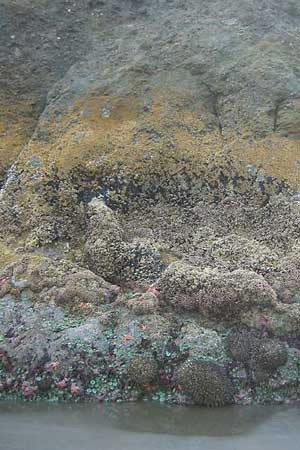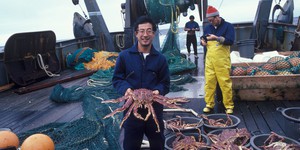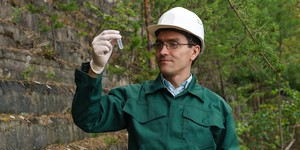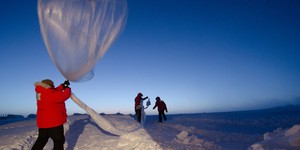Abstract
Have you ever been to a tide pool during low tide? Some intertidal animals in the low tide zone are left in a tiny pool of water when the tides go out. Other intertidal animals that live in high tide zones may be left to dry out during low tide. How much time does each zone spend out of water during a tidal cycle?Summary
Sara Agee, Ph.D., Science Buddies

Objective
In this experiment you will measure the amount of time that different tidal zones (high, middle, and low) spend out of the water during one tidal cycle.
Introduction
The intertidal zone is where the ocean meets the land. More specifically, the intertidal zone is the area between the highest and lowest tidal extremes. Organisms that live in the intertidal zone live in an extreme environment and are constantly battling several environmental stressors: waves, turbulence, temperature changes, sun exposure, air exposure, and higher salinity. Along most shores the intertidal zone can be divided into three subzones: high tide zone, middle tide zone, and low tide zone. Each zone has unique properties and often has a unique set of organisms which live there.
 Image Credit: Wikipedia / Public Domain
Image Credit: Wikipedia / Public Domain
The high tide zone is covered by water only during high tide. There is very little vegetation in the high tide zone, but you will find some green algae. You will also find crabs, barnacles, limpets, anemones, sea stars, chitons, mussels, and sea snails. The middle tide zone is covered by water about half of the time and is constantly experiencing wave action. You will find more seaweed vegetation here. You will also find anemones, barnacles, chitons, crabs, green algae, isopods, limpets, mussels, sea lettuce, sea palms, sea stars, snails, sponges, and whelks. In the high and middle tide zones rock pools can provide a habitat for small fish, shrimps, krill, sea urchins, and zooplankton who are trapped in the tidepool between the tides.
The low tide zone is only exposed during the lowest tide, and spends most of the time submerged under water. Some of the organisms that live in this zone need to stay in the water and cannot survive the longer periods of dryness found in the high or middle tide zones. Organisms you would find in this zone are abalone, anemones, brown seaweed, chitons, crabs, green algae, hydroids, isopods, limpets, mussels, nudibranchs, sculpin, sea cucumber, sea lettuce, sea palms, sea stars, sea urchins, shrimp, snails, sponges, surf grass, tube worms, and whelks. The low tide zone is highly productive, and has a very high level of biodiversity.
In this experiment you will measure the amount of time parts of your local shoreline spend out of the water during a tide cycle. Will you be able to use you data to identify the three tidal zones?
Terms and Concepts
To do this type of experiment you should know what the following terms mean. Have an adult help you search the internet, or take you to your local library to find out more!
- intertidal zones
- high tide zone
- middle tide zone
- low tide zone
- tide tables
- tide pools
Questions
- What happens to animals living in each tidal zone during low tide?
- How much time does each zone spend out of water during a tide cycle?
- Do the tide zones spend very similar or very different lengths of time out of the water?
Bibliography
- Read about the different types of shores and how they are divided into different tidal zones at this page from the New Hampshire Public Television Series Nature Works :
NHPTV, 2006. "Nature Works: Shores," New Hampshire Public Television. Retrieved October 30, 2006. - MBAQ, 2006. The Rocky Shore, Monterey Bay Aquarium, CA. Retrieved October 30, 2006.
- Wikipedia contributors, Intertidal zone, Wikipedia, The Free Encyclopedia. Retrieved October 30, 2006.
- Fowler, A., 1997. Life in a Tide Pool, New York, NY: Scholastic Library Publishing.
Materials and Equipment
- watch
- tide tables (check your local newspaper)
- long stakes
- hammer or mallet for driving in stakes
- measuring tape
- electronic timer
- a beach or shoreline
- an adult to take you to the beach and supervise the experiment
Experimental Procedure
- Check the tide tables of your local newspaper to find a day when you can follow the tides from high tide to low tide during a reasonable time period. For example, if high tide is at 10 a.m. and low tide is at 4 p.m. then this is reasonable, and you can do your experiment during a fun day at the beach. But if the tide tables say that high tide is at 10 p.m. and low tide is at 4 a.m., this is not a reasonable time to do your experiment because it will be dark and potentially dangerous.
- Pack your bag with things you will need for your experiment. You should bring your notebook, a pencil, a timer, a watch, several long stakes, and a tape measure. You will also need to prepare a data table to bring with you to write down and record your data:
Stake Number Distance (m) Time Staked (00:00:00) Time Submerged (hrs) Time Exposed (hrs) Which Zone? (high, mid, or low) 0 1 2 3 etc... - On the right day and at the right time go to the beach with your bag of supplies. Get to your field location a bit early to decide where you will set up your experiment.
- At high tide (as determined by checking your watch) place your first stake at the edge of the water and start your timer.
- Place a new stake every hour at the edge of the water and write down the time in your notebook in hours, minutes, and seconds (00:00:00) using your timer. Do not stop the timer at any point in the experiment, keep it going for the duration of the experiment.
- Repeat step 5 until your watch tells you that it is low tide. Place your final stake and record the time in your data table.
- Measure the distance between your stakes with the tape measure and write the distances in your data table.
- Remove all of your stakes and clean up your study area COMPLETELY! Remember, anything you leave behind could end up in the water and impact the animals that live there.
- When you get home, you are ready to make your calculations and analyze your data. You want to know how long each section spends under water and out of water during one tidal cycle.
- To calculate how long each section spends out of water, count the number of stakes placed after the section and multiply by 2. This will calculate the time in hours for each section.
- To calculate how long each section spends in the water, count the number of stakes placed before the section and multiply by 2. This will calculate the time in hours for each section.
- Can you use your calculations to identify the borders between the three intertidal zones? Where do you think the borders of the three zones are? Is there any other physical evidence to support your hypothesis, like stripes on rocks, or types of animals found?
Ask an Expert
Global Connections
The United Nations Sustainable Development Goals (UNSDGs) are a blueprint to achieve a better and more sustainable future for all.
Variations
- Do the same kinds of animals live in each tidal zone? Spend a day at the tide pools during lowest tide and look for organisms. Write down which organisms you see and where using a field guide to help you identify the organisms you see. How many are there? How far are they from the water line? Do some organisms live in the high tide areas, while others live in the low tide areas?
- Do tidal organisms have adaptations that help them live in such an extreme environment? How do they stay in a place where they are battered by waves and tides each day? Examine organisms that live in the tidal zone and look for evidence of adaptations which allow them to live there. Do they attach to the substrate? Do they burrow in the sand? Do they have anchors to keep them in place? Do they build tubes or other structures for protection?
- The angle, or slope, of the beach can have an effect on the rate at which water rises and falls during the transitions between high and low tides. Try making a water box that you can set at different angles, then add and remove water from the box. Does the water level rise faster or slower depending upon the angle?
- In this experiment you have placed one stake at the leading edge of the water, but what if the beach front is curvy? For a more complex experiment, you can place several stakes along the leading edge of the water following the contour of the beach. Will different sections follow the same patterns?
- The magnitude of the high and low tides changes with the phases of the moon. You can also repeat your experiment during different moon phases. Will your results be similar or different? For an experiment on how moon phases correspond to changing tides, see the Science Buddies experiment The Moon and Tides.
Careers
If you like this project, you might enjoy exploring these related careers:










